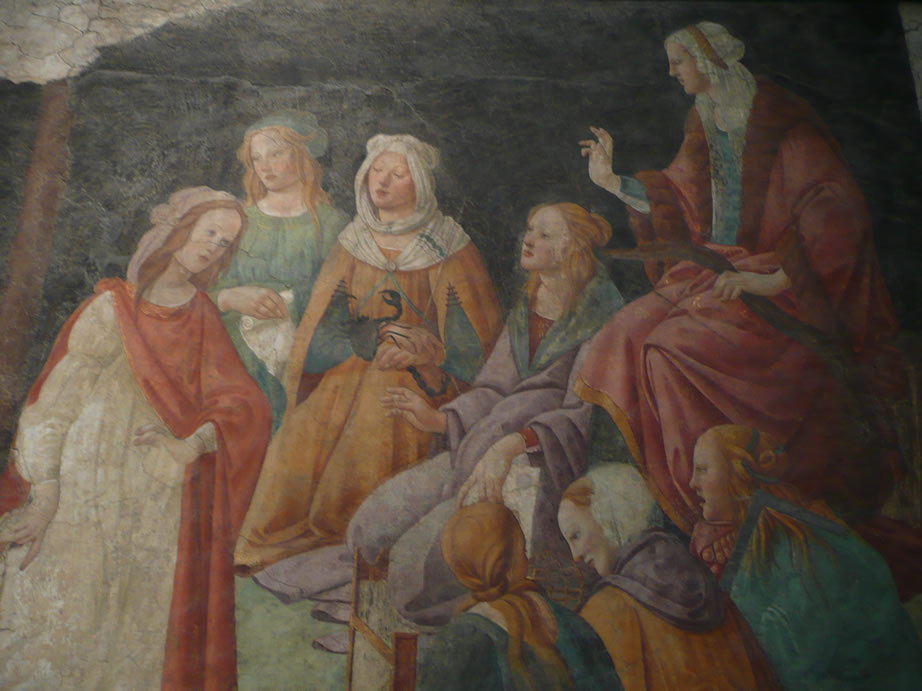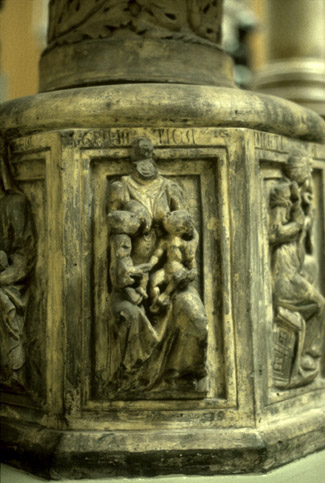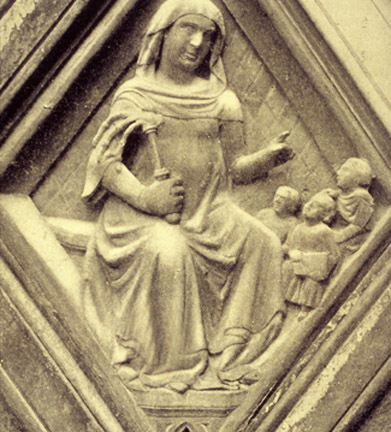Grammar: Carrot or stick?
« previous post | next post »
On my recent trip to Paris, I took time out Wednesday evening to go to the Louvre, which is open until 10 (that's 22h for those unambiguous Europeans) on Wednesdays. My eyes happened to encounter Un jeune homme présenté par Venus (?) aux sept Arts libéraux, which reminded me that one of these lovely young ladies would represent Grammar. Here they are, with Venus (whose question mark is in the Louvre label — that's not my editorial addition1); I've omitted to photograph the young man.

Since it's clear that the top middle one is Logic (aka Dialectic), with her scorpion, and since Logic is one of the three liberal arts in the Trivium, I assume that one of the women on either side of her is Grammar — let's say the lady to her left holding a scroll.2 Here she is in close-up (you can click on this or the above image for a bigger version):

Quite a charming-looking person, perhaps a little shy and young, but not at all offensive, right?
Seeing this image spurred me to look around on the web for other photos of paintings and scuplures of the seven liberal arts, and specifically Grammar, just to see if they all were so appealing. I found a lot of nifty ones — it would make a fun, if specialized, coffee table book — but in particular enjoyed this website which I found linked to on Woodslot. There, I saw a whole range of sculptural depictions of Grammar, but none varied more than these two; check them out!
Grammar as a mother nursing her children:

Grammar with what appears to be a whip with multiple tails, smiling slightly as she prepares to lash her tiny, trembling students:

Which is grammar to you?
(In many of the sculptures and images Grammar is represented with a staff or stick of some kind, or maybe reed; in most but not all there are children around her or sometimes him. I've probably misinterpreted that whip thing.)
1 Actually, I wonder if the question mark indicates that they were wondering if the lady doing the introduction might be Philosophy, since she is commonly represented with the seven liberal arts in a kind of queen-of-sciences role.
2Now I read a little more about the iconography of the seven liberal arts, I see that the bow was also often associated with Logic/Dialectic, as well as the scorpion, which means that there might be two Logics in this picture. The bottom three I think are, from left to right, music (holding a harp), astronomy (holding an astrolabe), and geometry (holding a right angle). That means the remaining four are grammar, rhetoric, logic and arithmetic. Scorpions and bows are both associated with logic, and the other two are holding scrolls, so it's kind of hard without further research for me to tell who is who. I think I see some kinds of circles on the paper in the rightmost paper-holder's hand, which would suggest that that one is also geometry…call her arithmetic, then; then the bow and scorpion I'd imagine are rhetoric and logic, and grammar is left as the last paper-holder.
Bunny Mellon said,
July 4, 2008 @ 12:48 am
You should probably say it's by Botticelli. 'Venus' certainly does not resemble the Uffizi one, The Birth of Venus . I wonder what the grounds are for thinking Venus. There's also a tenth figure, a child, at bottom left.
What are the dates of two and three?
Number three takes the form of a dwarf (big head and arms, small body), yet she dwarfs the bystanders who look up at her. It could just be that the big head is to take account of foreshortening if the image is placed up high.
I'm sure all the linguists think she's number two. Yea! And the rest of us think three (boo). I don't get it with the Botticelli, though. Who would make Grammar look as you say shy, young and inoffensive? None is a good description, except 'shy', perhaps.
Bunny Mellon said,
July 4, 2008 @ 12:51 am
Ah, sorry, I now see that was only your speculation. Sure, well, why not? Certainly a refreshing view of Grammar, I suppose.
dr pepper said,
July 4, 2008 @ 3:35 am
If that is Venus, she's severely overdressed.
pandammonium said,
July 4, 2008 @ 4:52 am
Perhaps Ms Grammar with the whip is Ms Prescriptive Grammar and the one without is her sister, Descriptive.
linda seebach said,
July 4, 2008 @ 7:43 am
"let's say the lady to her left holding a scroll."
No, your left; her right. A picture, not a mirror.
Faldone said,
July 4, 2008 @ 8:10 am
@linda seebach. At least in my dialect, and any dialect of US English that I have experienced, right and left in a picture is the right and left of the observer of the picture. I have seen the opposite in Australian English but it was from the person in the picture.
Joe said,
July 4, 2008 @ 8:26 am
Faldone: left and right in a picture is our left and right as the observer, sure. But why on earth would we say "to HER left" if we meant "to the left of her"?
Yes, I know it's done sometimes. I find that arbitrary, confusing, and misleading. Even if that's how it's done, it makes ever so much harder, for example, to figure out which of the disciples in the Last Supper is actually Jesus' mistress. [/ObLeonardo ref]
By the way, do we also call it "her left hand" just because it's to our left?
Squander Two said,
July 4, 2008 @ 8:35 am
The way I speak British English, "to her left" is from my point of view while "on her left" is from hers.
Fred Bone said,
July 4, 2008 @ 11:00 am
A 2.9 megabyte image is perhaps a little excessive for a blog entry. Could you please replace it with a reduced-resolution one? Or put it further down, where it will only be called up when one views the "rest of this entry"? Not everyone is on broadband.
Sili said,
July 4, 2008 @ 11:33 am
Interesting difference in usage of "to her left". I'll have to keep that in mind, I suppose.
To me grammar was no. 3 in German in secondary school. Number 2 when I took propaedeutic Latin at uni of my own volition.
MMcM said,
July 4, 2008 @ 11:54 am
The rest of the picture, including the young man _and a small child_, can be seen on the Louvre site (http://cartelfr.louvre.fr/cartelfr/visite?srv=car_not_frame&idNotice=1181). Or even better at http://www.wga.hu/frames-e.html?/html/b/botticel/5allegor/51lemmi.html.
Often, grammar is a teacher. If that were the case here, she would be presenting him (Lorenzo Tornabuoni?) and near her charge.
In that scheme:
Grammatica small child
Rhetorica scroll
Dialecta scorpion
Musica musical instrument
Arithmetica paper w/ formulae
Geometria right angle
Astronomia armillary sphere
leaving:
Sapientia olive branch
MMcM said,
July 4, 2008 @ 11:57 am
Make that http://www.wga.hu/frames-e.html?/html/b/botticel/5allegor/52lemmi.html. Darn frames.
Bunny Mellon said,
July 4, 2008 @ 12:42 pm
MMcM, that's a much better , bigger image. Thanks.
So it turns out Venus (for it is actually she) is the one standing next to the boy, not the lady in specs (or is that just a crack?) sitting on (our) right holding a snake, possibly.
But Heidi Harley, I told you I think Grammar is number three. Now you have to tell me where the #3 image is from.
Mark Liberman said,
July 4, 2008 @ 1:29 pm
I replaced the original image with a somewhat smaller one, for the sake of those whose internet connections or computers balked at such a large (~3MB) image.
The original can still be seen here.
Heidi Harley said,
July 4, 2008 @ 7:21 pm
Hi all — thanks much, Mark, for fixing that image size! my apologies; made the post and then was travelling so couldn't log on and check how things were going.
Also realized I forgot to say where the images 2 and 3 were from; thanks for the reminder, Bunny! 2 is from a cathedral in Pisa, and 3 is from Florence. I got them both from the page I link to above, which has a more thorough description of the sources of the images:
http://iconics.cehd.umn.edu/
nbm said,
July 6, 2008 @ 7:16 pm
Google got me a quick link to a short monograph on Botticelli by Barbara Deimling (Taschen, 1994, English trans 2000) whose analysis matches MMcM's. Grammar is the pretty teacher escorting the boy, she says, and the figure on the raised seat is Wisdom whose olive branch represents "the harmony prevailing among the Arts." Venus has nothing to do with it, though she may appear in the pendant image of Lorenzo's bride receiving flowers from the goddess.
Also, that's not a harp, it's a portative organ (cf. images of St. Cecilia).